You may have noticed a lot of changes in the way Avaza looks and feels recently, and one of the biggest changes by far is the option to view tasks in both List-view and as Kanban boards.
What are Kanban Boards?
Kanban boards may have started out as a way for Japanese companies to become more efficient, but in recent years they have been adopted by all sorts of business models. From HR and recruitment companies to software developers, Kanban boards have helped improve workflow models in all kinds of situations.
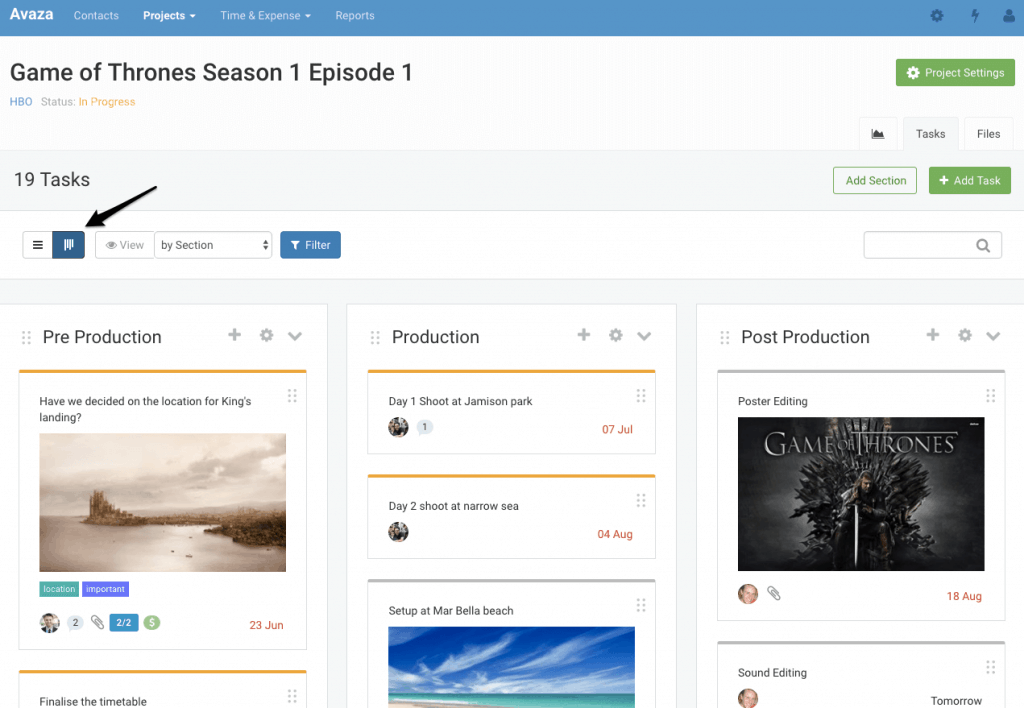
Figure: Project-Level View of Kanban Boards
How Kanban Boards Work in Avaza?
While developing Avaza, we wanted it to have everything a business would need to get more organized and efficient, which is why adding Kanban boards has been a huge milestone for us. Now you can view all your tasks in either list-view, or in Kanban form, and either choose one system or toggle between the two.
Kanban view initially converts your task lists into cards that are shown in columns, allowing you to view all your project tasks in a new light. Let’s run through the basics of using, and making the most of, Avaza in Kanban view.
1. Create Tasks (or Cards)
In much the same way as in List-view, there are three ways of creating cards in Kanban view.

Figure: Three Methods of Creating Kanban Cards
- The +Add Task button on the top right
- The + icon at the top of each section
- The +Add a New Task option at the bottom of your task list.
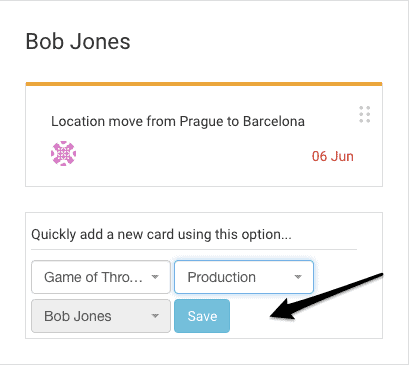
Figure: Create Kanban Cards In-Line
While creating a new card (or task) in Kanban works in exactly the same way as in List-view, the great thing about Kanban cards is that they expand to show you more of the information you add into the cards.
For example, instead of a maximum of 3 color-coded tag icons, you will be able to see the name of the entire tag, and all the tags you’ve added to that card. You can also set cover images to each card to provide you with more visual information about each card that is added to your project.
Kanban cards also, unlike tasks in list-view, can be moved both upwards and downwards, as well as side-ways. So you can drag & drop each card not just vertically to re-order lists, but also horizontally, to move them from section to section.
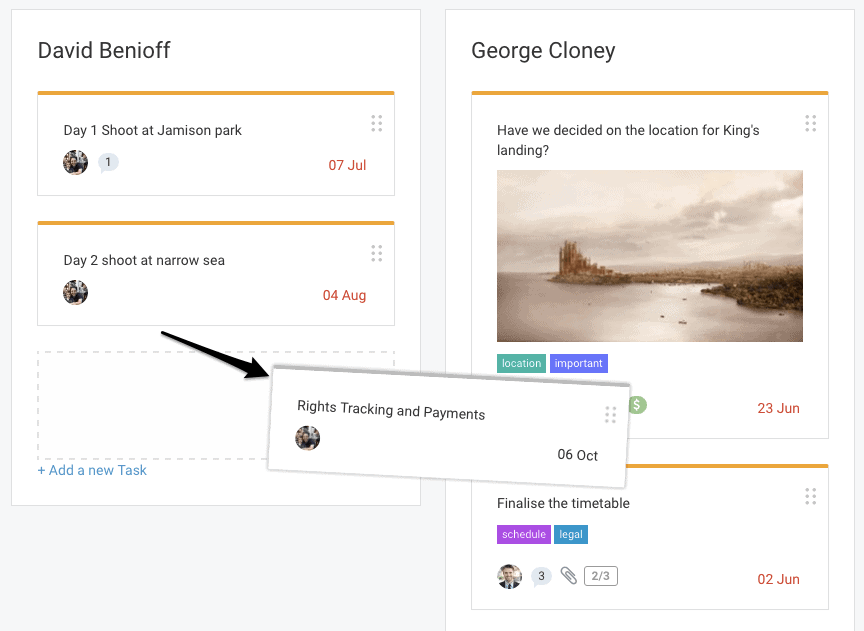
Figure: Drag & Drop Kanban Cards Horizontally or Vertically
2. Add Card Cover Images
Avaza’s Kanban view has been designed for teams that need to view tasks in a more visual way. One of the new features within the Kanban view, is adding cover images for individual cards.
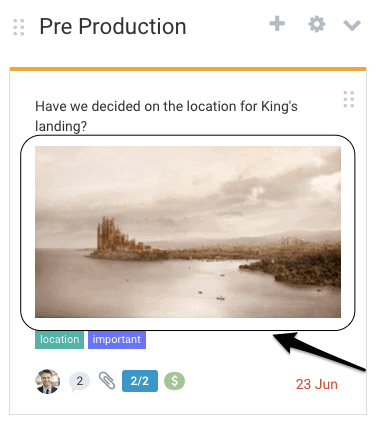
Figure: Add a Kanban Card Cover Image
To get started, click on any card (or create a new card) in Avaza.
Click on Add Attachment, and upload the cover image of your choice if you don’t have the necessary image already uploaded.
Click on “Make Cover” to feature that image as a cover for that card.
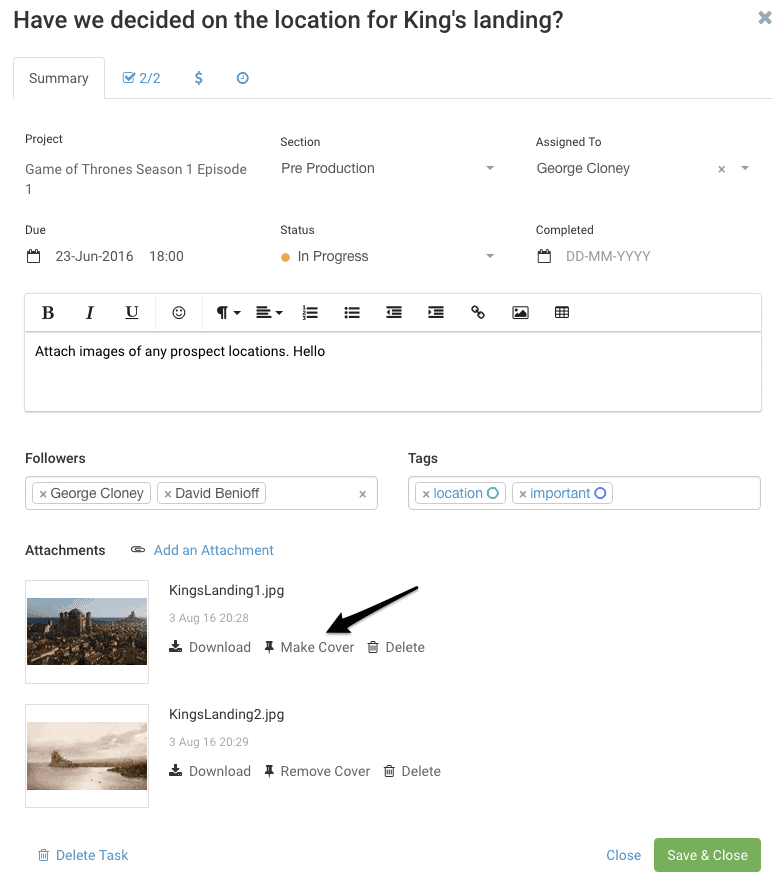
Figure: Add/Remove Cover Image on Kanban Cards
Click Save & Close.
While you can set images as covers in both list-view and Kanban view, you can only view them as such in Kanban view.
3. Group Tasks
Similar to List-view, Kanban-view lets you group tasks by a few different fields. You can choose between Section, Due Date, Assigned To and Status. Whereas in List-view the various groups are displayed in list form one after the other, in Kanban-view, you see these laid out as columns side-by-side.

Figure: Group Tasks by Section, Due Date, Assigned To or Status
Section
Sections allow you to setup any form of workflow your team prefers. Instead of being limited by deadlines, assigned to and status, you can choose a fourth workflow option that may allow your team to work better. For website developers, for example, this may be as simple as setting up a section each for design work, bugs, copy and administrative tasks.
Grouping by sections allows you to re-arrange the order of the sections, access section settings and re-arrange cards within each section using drag & drop. You can also move cards sideways, as mentioned earlier, which allows you to quickly drag & drop cards from one section to another.
Tasks grouped by section display three buttons to the right of the section title. These buttons allow you to create tasks quickly, change section settings, and collapse the entire section and its task list.
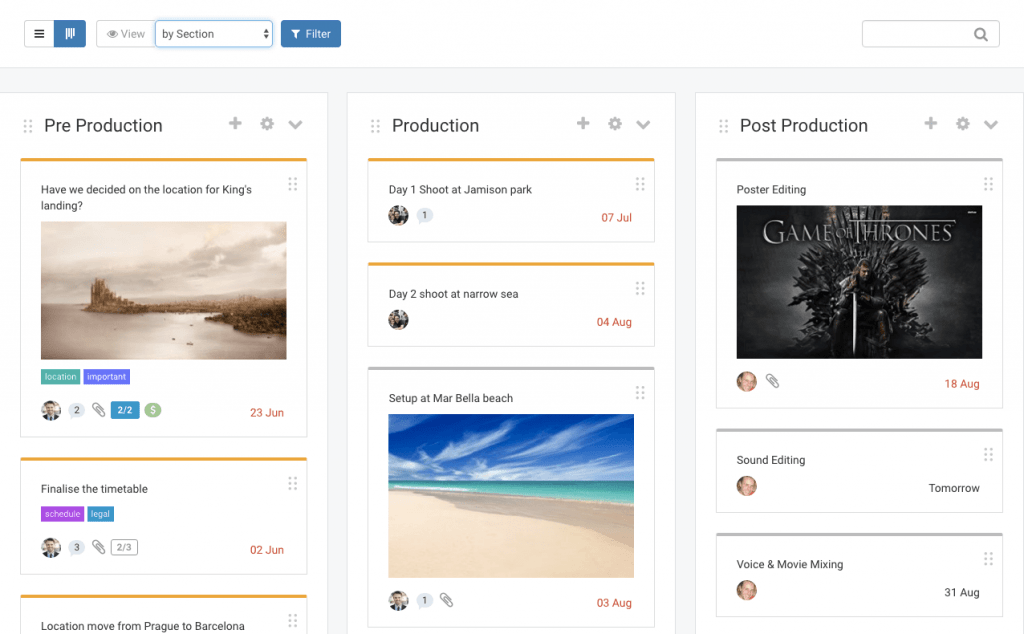
Figure: Group Cards by Section
Due Date
Grouping by due date divides all cards into two columns: with due date and without due date. The “with due date” column displays cards in the order they are due, from earlier to latest. This is most convenient when you want to get a quick overview of where your project stands in terms of how much work is overdue. You can also easily prioritize, or re-assign tasks that need to be completed ASAP because they impact tasks further down the list.
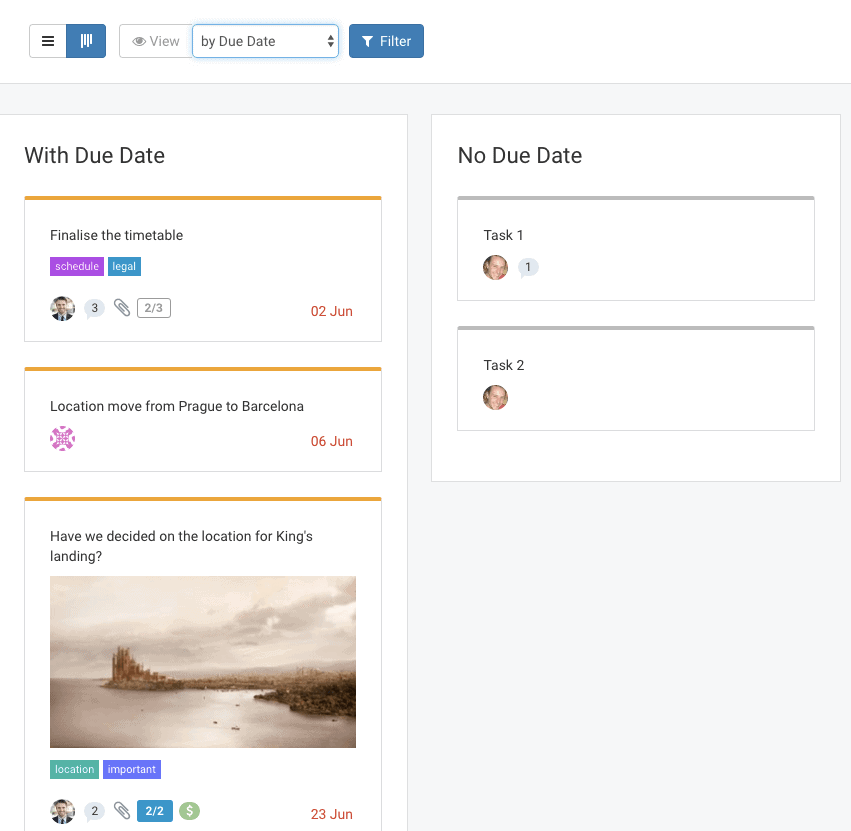
Figure: Group Cards by Due Date
Assigned To
View cards in columns by team member they are assigned to. You can drag & drop tasks from one user to another to re-assign them. Grouping by Assigned To allows you to review workload by team member. You may notice when you group tasks this way that one team member has a lot more on their plate than another, and can then quickly reallocate tasks to make workload more even.

Figure: Group Cards by Who They are Assigned To
Status
View tasks by their status in three simple columns. Drag & drop tasks between statuses to quickly update the status. Being able to at one glance see tasks that are completed, in progress or not started provides you with an eagle eye view of the project.

Figure: Group Cards by Status
3. Use Filters
Overwhelmed by the number of cards in a project? Quickly filter through them to whittle down your list to a more manageable number.
The Filter pop-up lets you narrow tasks down by Status, Assigned To, Due Date and Tags.
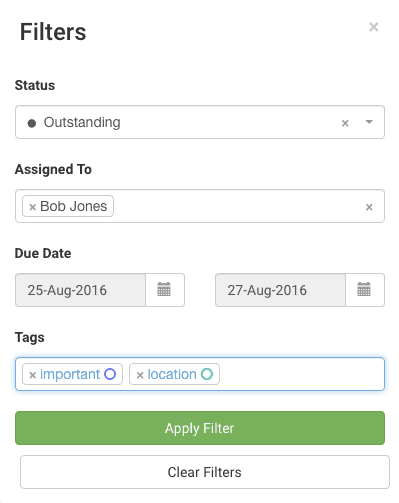
Figure: Filter Tasks by Status, Assigned To, Due Date and Tags
Status
By default this is set to only Outstanding (does not include completed tasks). However, you can decide to filter by other statuses or remove the status filter entirely to view all cards. As mentioned earlier, being able to filter or group by status lets you quickly understand how much of your project is complete, not started yet or in progress.
Assigned To
Select one or more team members to filter through cards. As with grouping, filtering by team member shows you only cards assigned to that one person. You can then quickly review how much work they’ve yet to start on, have completed or are currently working on.
Due Date
Select a date range to filter cards due within those dates to get an overview of how your upcoming weeks are looking. This is a great way to check and see if maybe too much work has been allocated to be completed in one particular week or set of days, allowing you to reschedule it in a more manageable way.
Tags
Select one or more tags to view all the cards that have any of those tags applied to them. Tags are great at helping sort through cards. For example, you can use tags to mark cards with specific actions that need to be taken, or highlight which part of the project the card is most relevant to. If you’re a design team, you may use tags that highlight where the design is going to be used.
Kanban-view is unique in that you can see all the tags assigned to a card instead of just the color-coded circles that are displayed in List-view. Since the cards expand to show you more information, you can add multiple tags and they will all be visible to you in the main project view window.
4. Search through Cards
Another easy way to find the right card quickly is the improved search function. You can now find any card without having to scroll through your entire Kanban board.

Figure: Search Through Cards at Project-Level
5. Icons Provide you with Quick Overview
In our effort to make Avaza more visual, we have added a way for you to view the basic information about a card without having to click on it.
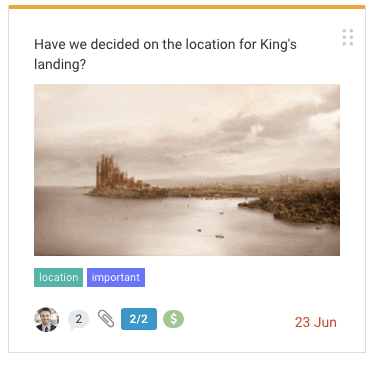
Figure: Icons Provide Context at a Glance
Task Status
The top border on each card indicates its status. Grey = not started, Orange = In Progress and Green = Completed. Without having to filter or group cards by status, you can quickly see the status of each card on the board.

Figure: The Colored-Bar Indicates Task Status
Tags
Right under the Card title (or cover image, if you have one) you will see color-coded tags with their titles. You can add as many tags as you want because in Kanban-view, the tags are displayed in full along with their title.

Figure: Tag Titles are Color-Coded
Assigned To
In Kanban-view, you will see the profile picture of the person the task is assigned to.
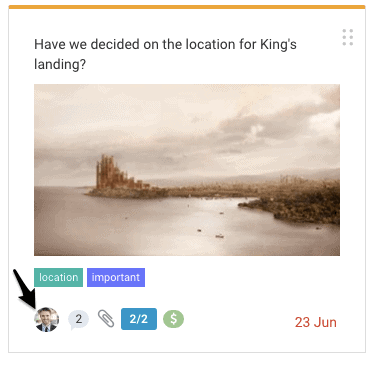
Figure: Profile Pictures Indicate who the Task is Assigned To
Comments
The speech icon indicates the number of comments on the card.
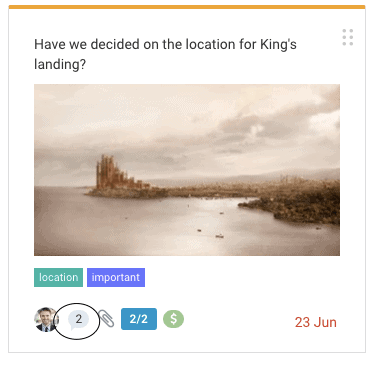
Figure: Speech Icon Indicates Number of Comments
Attachments
The paper clip icon indicates that there are attachments on this task. You can access the attachments by either opening the card itself or by going through the files tab.
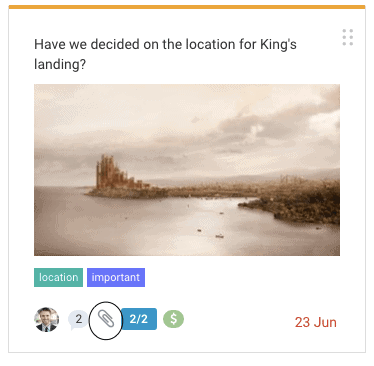
Figure: Attachment Icon Indicates Cards with Attachments
Sub-Tasks
Once we added sub-tasks, we needed to provide you with a way of ascertaining which cards had sub-tasks within it. The Sub-Tasks icon shows you two counts. The first is the number of completed sub-tasks, and the second is the number of total sub-tasks. They are shown in the format x/y. The icon is displayed in blue if all sub tasks are marked as complete.
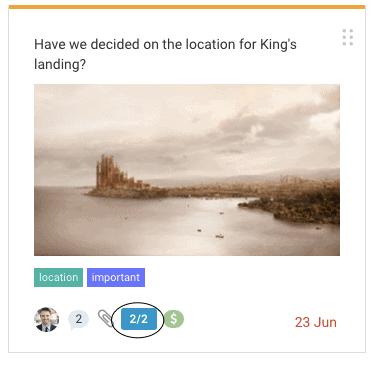
Figure: View Total & Completed Sub-Tasks on a Card
Fixed Amount
Fixed Amount support is a new feature, and its icon allows you to see which card has fixed, or milestone payments, attached to it, as well as whether or not they have been invoiced. The icon is blue when the amount is not invoiced, and green once it has been invoiced.

Figure: Fixed Amount Icon Shows Cards with Milestone Payments
Due Date
The due date for the card is also visible with Kanban boards. Once a task is overdue, this is displayed in red.
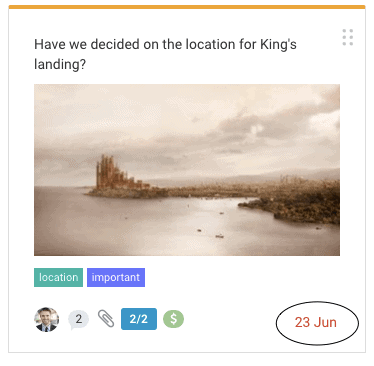
Figure: Quickly View Due Dates, and Overdue Tasks
We’re very excited about launching Kanban boards for Avaza users, and we certainly hope you’ll love this new way of viewing your project tasks. Do share your thoughts with us, including unique workflows your team may be using to get more done!
1 Comment
Thank you very much for this functionality: Drag & drop tasks between statuses to quickly update the status.